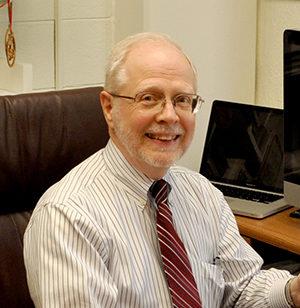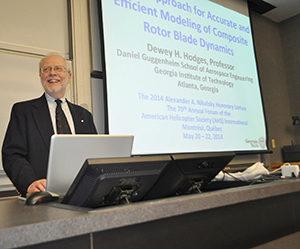When Prof. Dewey H. Hodges accepted the 2014 American Helicopter Society (AHS) Alexander Nikolsky Distinguished Lectureship, he joined a renowned group of highly respected experts in the field of rotorcraft engineering.
Turns out, he also joined a group of very familiar faces.
“I’m not the first Georgia Tech professor to receive this. [Former AE chair] Robin Gray was a Nikolsky Lecturer. And I attended the lecture when [former AE chair] Bob Loewy, [former GTRI faculty] Charles Crawford, and [AE professor] Dan Schrage gave it,” said the longtime GT-AE professor who is also a Fellow of AIAA, ASME and AHS.
“I thought it was a great opportunity then, but I never thought I’d ever give it. My work was too theoretical.”
Suffice it to say, the AHS did not concur.
Since accepting the year-long lectureship in May, Hodges has traveled to China, South Korea, and several venues across the country to give the lecture, "Unified Approach for Accurate and Efficient Modeling of Composite Rotor Blade Dynamics."
“It’s been one of the most exciting honors of my career,” said Hodges after delivering the Nikolsky before the hometown crowd at Georgia Tech on Nov. 21.
“And I don’t know of any other universities who’ve had this many Nikolsky lecturers, so that’s great for Georgia Tech, too.”
Hodges' lecture looks at how to achieve accuracy comparable to that of 3D finite element analysis but with a significant savings in computational effort.
"The vehicle for this approach is a mathematical technique called the variational asymptotic method (VAM). I summarize the modeling approach and presents some of the key equations of the resulting models."
Hodges’s talk also emphasizes the versatility of VABS, a cross-sectional analysis tool for beams that was first developed in the 1990s. Widely used by companies in the rotorcraft, wind turbine, and aircraft industries, this model continues to be refined and applied in new ways. One of its earliest proponents, Carlos Cesnik, and one of its chief architects, Wenbin Yu, are both former students of Hodges’s.
“No matter how complex a rotorcraft is, no matter what it’s made of, VABS will give you the best elastic constants” which are a measure of a beam’s stiffness, Hodges noted.
A journal article, summarizing his lecture, is in the works. In the meantime, Hodges is grateful that the Nikolsky lectureship allowed him to travel the world, connecting with other engineers and academics who are as intrigued as he is by the aeromechanics of rotorcrafts.
“I know of no other area of aerospace engineering that is as interdisciplinary. And that’s what makes it exciting,” he said.
“You have blades vibrating and oscillating. You have to develop enough lift to fly. At the same time, you have to balance the lift on the right and left, which is controlled with cyclic pitch through the swash plate. You put it all together, and it’s one complicated beast.”
Reflecting a moment on that “complicated beast,”Hodges smiles, and adds:
“A former colleague, Grady Wilson, used to sum it up pretty well: ‘They (rotorcraft) don’t actually fly. They are so ugly that the air just submits to them.’”
Note: No summary of the 2014 Alexander Nikolsky Lecture would be complete without noting, as Dr. Hodges does, the many contributions that colleagues and mentors have made to the field. In particular, Hodges reminds all listeners that he benefited greatly from the bold leadership of Stanford University Professor Holt Ashley (his masters advisor) and Dr. Bob Ormiston, his boss – and inspiration – during his 16 years at the Ames Research Center. Ormiston was recently named as the 2015 Nikolsky Lecturer.
"It is Divine providence that always put me in close proximity to those who are smarter than I."

2014 Nikolsky Lecturer Dr. Dewey H. Hodges
(text and background only visible when logged in)

Dr. Hodges delivers the Nikolsky Lecture to the hometown crowd, at Georgia Tech, Nov. 21